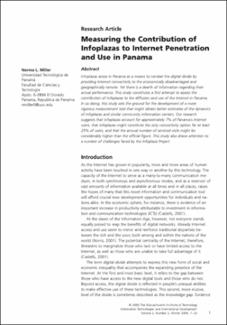| dc.contributor.author | Miller, Norma L. | |
| dc.date.accessioned | 2017-08-16T16:56:21Z | |
| dc.date.accessioned | 2017-08-16T16:56:21Z | |
| dc.date.available | 2017-08-16T16:56:21Z | |
| dc.date.available | 2017-08-16T16:56:21Z | |
| dc.date.issued | 2004-12 | |
| dc.date.issued | 2004-12 | |
| dc.identifier.uri | http://ridda2.utp.ac.pa/handle/123456789/2822 | |
| dc.identifier.uri | http://ridda2.utp.ac.pa/handle/123456789/2822 | |
| dc.description | infoplazas arose in Panama as means to combat the digital gap by providing Internet connectivity to the economically disadvantaged and geographically remote. Yet there is a dearth of information regarding their actual performance. This study constitutes a first attempt to assess the contribution of infoplazas to the diffusion and use of the Internet in Panama. In so doing, this study sets the ground for the development of a more rigorous measurement tool that might obtain better estimates of the dynamics of infoplazas and similar community information centers. Our research suggests that infoplazas account for approximately 7% of Panama's Internet users, that infoplazas might constitute the only connectivity option for at least 25% of users, and that the annual number of serviced visits might be considerably higher than the official figure. This study also draws attention to a number of challenges faced by the Infoplaza Project. | |
| dc.description.abstract | infoplazas arose in Panama as means to combat the digital gap by providing Internet connectivity to the economically disadvantaged and geographically remote. Yet there is a dearth of information regarding their actual performance. This study constitutes a first attempt to assess the contribution of infoplazas to the diffusion and use of the Internet in Panama. In so doing, this study sets the ground for the development of a more rigorous measurement tool that might obtain better estimates of the dynamics of infoplazas and similar community information centers. Our research suggests that infoplazas account for approximately 7% of Panama's Internet users, that infoplazas might constitute the only connectivity option for at least 25% of users, and that the annual number of serviced visits might be considerably higher than the official figure. This study also draws attention to a number of challenges faced by the Infoplaza Project. | en_US |
| dc.language | eng | |
| dc.language.iso | eng | en_US |
| dc.rights | https://creativecommons.org/licenses/by-nc-sa/4.0/ | |
| dc.rights | info:eu-repo/semantics/openAccess | |
| dc.subject | digital gap | en_US |
| dc.subject | connectivity | en_US |
| dc.subject | infoplazas | en_US |
| dc.subject | Internet | en_US |
| dc.subject | Panama | en_US |
| dc.subject | digital gap | |
| dc.subject | connectivity | |
| dc.subject | infoplazas | |
| dc.subject | Internet | |
| dc.subject | Panama | |
| dc.title | Measuring contribution of infoplazas to internet penetration and use in Panama | en_US |
| dc.type | info:eu-repo/semantics/article | |
| dc.type | info:eu-repo/semantics/publishedVersion | |
